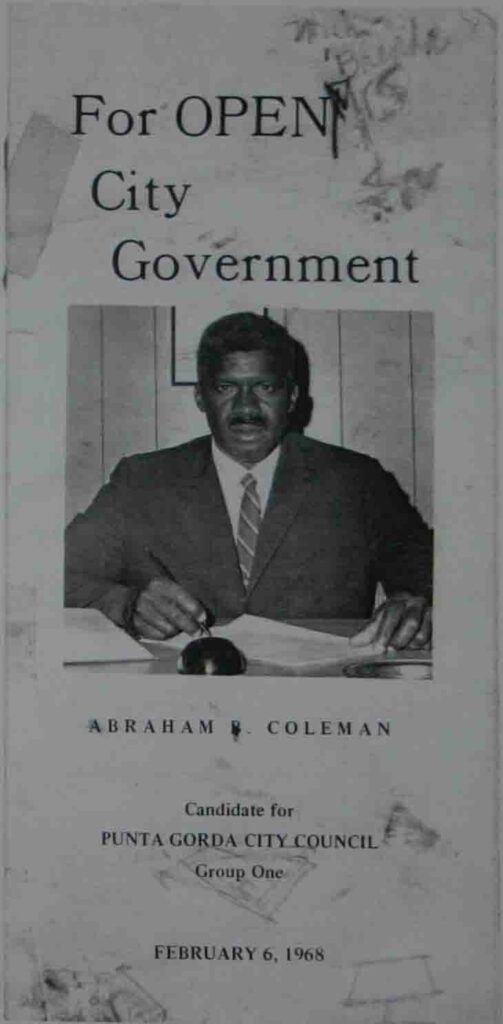Year
2023
Artist
Location
Baker Center School
311 E. Charlotte Avenue
Size
104′ w x 8.5′ h
Mural Creation Sponsors
2023:
Sushila Cherian
In Memory of Dr. JV Cherian
Congregational United Church of Christ
Kelly & Pete Gaylord
The Patterson Foundation
Saint Mary Baptist Church
In Memory of Pastor Isaac Thomas Jr
Community Foundation of Sarasota County
Shively Charitable Foundation
Lt. Col. Scot & Jill Shively
Penny Stiffler
The Community
Panel 8 – Government
To listen to an audio presentation of the history captured in this panel, click on this video.
Our local black community played a role in the town’s government from the start. On December 3rd, 1887, 34 registered voters (all men) met at Thomas Hector’s upstairs pool hall and voted to incorporate the town, establish a municipal government, and rename the town Punta Gorda. The voters included 4 black settlers: Sam Kenedy, O.B. Armstrong, E.C. Jackson, and Elihu Justice.
Two short years later, after Republican Benjamin Harrison was elected President of the United States, Robert Meacham, a prominent black Florida legislator and preacher, was appointed Punta Gorda’s postmaster. Back then, the postmaster position in a town was a political appointment from the federal government and a position of trust. Postmasters handled money and other federal agencies counted on them for honest opinions, so this appointment was significant to the black community.
Initial reactions to the appointment from the white residents in town were documented in Cantor Brown Jr.’s article on Meacham titled “The Life and Times of Robert Meacham.” Here is an excerpt:
Local citizens were furious at the news [of the appointment] and held an “indignation meeting.” When Meacham arrived in late May 1889 to claim the office, a DeSoto County newspaper labeled his appointment “a studied insult to the people of that town.” Meacham once more displayed that tenacity which so marked his efforts in the 1870s and, despite the animosity to his presence, remained in Punta Gorda for two years. By the time of his departure, he had turned the community’s anger into respect. The local newspaper [Punta Gorda Herald, March 7, 1902] later remembered of him, “…notwithstanding his color and his politics, he stood high in the esteem of the white people, to whom he was always respectful and accommodating.”
It wasn’t until 81 years after Punta Gorda’s municipal government was established by that 1887 vote, that someone from the black community ran for City Council. Abraham Coleman ran for election for Group 1 (now called District 1) in 1968. Here is a photo of his campaign flyer. He ran a strong race, but unfortunately lost.

The City would not have it’s first black council member until 2000 when John Murphy took over as the District 5 representative when Bill Richards passed away. The following February, John was officially elected to the position.
Here’s a short summary of the life of Robert Meacham and the role he played in Florida Government:
Born in 1835 in Gadsden County, Florida, Robert Meacham was the son of his white master and slave mother. Even though he was born into slavery, his father cared for him and was determined to provide him with an education. The local all-white school refused to teach him so he learned to read and write without them. This early experience taught him the importance of education being available to all, and as a young adult while working as a house servant in Tallahassee, he secretly shared his education with other slaves at night by candlelight.
By the end of the Civil War, it was said that Meacham was able to buy freedom for himself and his mother, and had started preaching to his fellow bondsmen. He was admitted to the African Methodist Episcopal (A.M.E.) Church conference for ordination in 1866 and appointed to the church at Monticello east of Tallahassee.
With the passage of the Reconstruction Acts in 1867-68, Reverend Meacham was enlisted by the state’s national Republican party as the delegate from Jefferson County. He worked to register 2300 voters (1747 were blacks), representing almost 10% of all registered voters in Florida at the time.
Meacham was placed on the Republican ticket for election as a delegate to the Florida Constitutional Convention and won unopposed in November 1867 in the mostly white Jefferson County. He pushed for a uniform system of free public education.
Meacham ran for election to the state senate (from Jefferson County) and won in a landslide. The constitution that he had helped to shape was also approved. Florida’s first Reconstruction legislature met on June 8, 1868 and he (representing upwards of 2000 black voters) commanded attention from both party leaders.
Republican Governor Harrison Reed courted Meacham and appointed him Jefferson County’s clerk of the circuit court in August 1868, a position considered the “boss” of the county. Robert was met with death threats as racial tensions in the county were high. He persevered and kept the tension to just talk.
In the 1869 session of the Florida legislature, Meacham emerged as chairman of the senate committee on education. With his guidance, Senate Bill 14 passed both houses and Florida’s public education system was born. He went on to be appointed Superintendent of Schools for Jefferson County and Monticello’s postmaster all while remaining in the Florida senate.
Rising in the political and religious (A.M.E Church) ranks over the next few years, Meacham decided to run for the United Stated Congress. His campaign to secure the nomination for the Republican party was a tough battle. In the end, he lost the nomination, and almost lost his life when two white men tried to kill him at his residence in October. The 1874 Florida election was filled with fraud, corruption, and intimidation, and as a result, control of both houses of the Florida legislature passed to the Democrats.
Thus began Meacham’s fall from political power. When his senate position ended in 1879, he remained in Tallahassee until 1887 when he was sent by the AME Conference to work with churches in southern Florida. In Key West, he served as a clergyman for the Zion AME Church. He then went to Punta Gorda in 1888 to assist with the formal organization of the Bethel AME Church.
Later in 1888, he moved to Fort Myers as reported by the Fort Myers Weekly Press on November 8th, saying, “Rev. Meacham, formerly of Punta Gorda, is the colored minister of the AME Church here. He has started a project for the erection of a church for his people.” In late May he returned to Punta Gorda to assume the role of Postmaster which he held until May 1892 (according to the Fort Myers Press, May 19, 1892).
By 1896, reports show Meacham had moved to Tampa with his family and ran a shoe shop. He died on February 27, 1902 at the age of 67. He was remembered by the AME Church as being one of the first ordained to the ministry, famous in his day for building houses of worship. He was also a former slave who with little education, made his mark on the state of Florida, leaving legacies that endured.
Panel 8 of the new Local Black History mural captures Robert Meacham and the first railroad depot at the “wye” in the tracks which served as the post office during his postmaster tenure.






 Support Provided by the Community Foundation of Sarasota County & the Shively Charitable Foundation
Support Provided by the Community Foundation of Sarasota County & the Shively Charitable Foundation